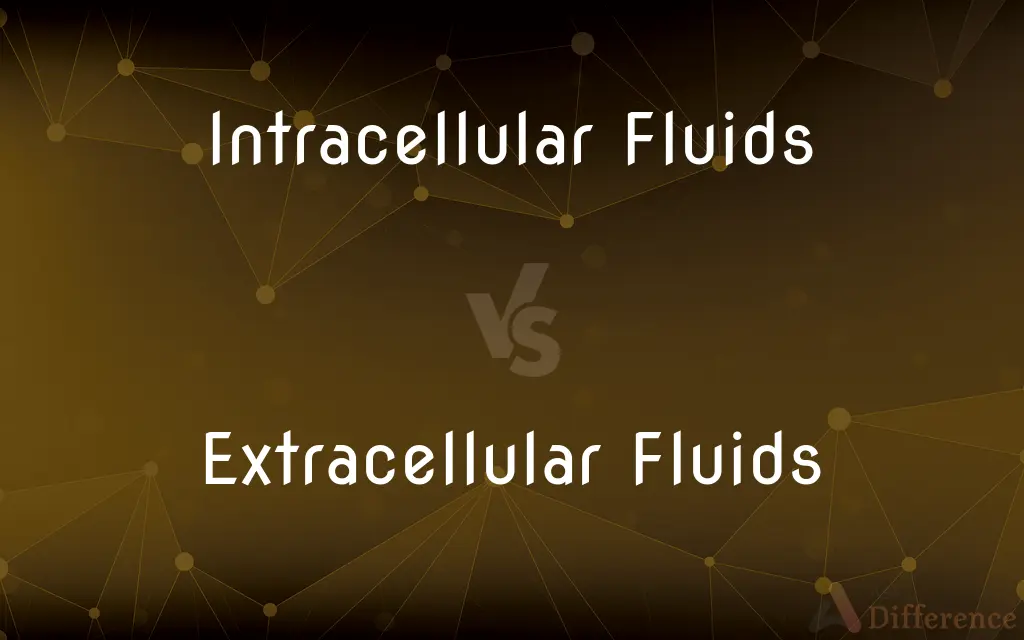Intracellular Fluids vs. Extracellular Fluids — What's the Difference?
Edited by Tayyaba Rehman — By Maham Liaqat — Published on June 26, 2024
Intracellular fluids are contained within cells, supporting internal processes, while extracellular fluids surround cells, facilitating nutrient transport and waste removal.

Difference Between Intracellular Fluids and Extracellular Fluids
Table of Contents
ADVERTISEMENT
Key Differences
Intracellular fluid (ICF) is the liquid found inside cells, constituting about 60% of the body's total water content. It plays a crucial role in cellular metabolism, providing a medium for biochemical reactions and helping maintain cell structure and function.
Extracellular fluid (ECF) is the fluid outside cells, making up approximately 40% of the body's water content. It includes interstitial fluid, plasma, and other bodily fluids, acting as a transport system for nutrients, gases, and waste products between cells and the bloodstream.
The composition of ICF and ECF differs significantly. ICF is rich in potassium and phosphate ions, which are essential for cellular activities. In contrast, ECF has higher concentrations of sodium and chloride ions, crucial for regulating fluid balance and transmitting nerve impulses.
The balance between ICF and ECF is vital for homeostasis, ensuring that cells function properly within their environment. This balance is maintained through mechanisms like osmosis and active transport, which regulate the movement of substances across cell membranes.
Diseases and disorders can disrupt the balance between ICF and ECF, leading to conditions such as dehydration, edema, and electrolyte imbalances. Understanding the roles and characteristics of these fluids is essential for diagnosing and treating such conditions.
ADVERTISEMENT
Comparison Chart
Location
Inside cells
Outside cells, in blood vessels, between cells
Percentage of Body Water
About 60%
About 40%
Main Functions
Cellular metabolism, maintaining cell structure
Transport of nutrients, waste removal, maintaining fluid balance
Ion Concentration
High in potassium and phosphate
High in sodium and chloride
Clinical Relevance
Disruptions can affect cellular function and metabolism
Imbalances can lead to dehydration, edema, electrolyte issues
Compare with Definitions
Intracellular Fluids
Involved in DNA replication and cell division.
Intracellular fluids provide the necessary environment for mitosis.
Extracellular Fluids
They remove waste products from cells.
ECF facilitates the removal of carbon dioxide and metabolic wastes.
Intracellular Fluids
Act as a buffer against external changes.
ICF helps cells adapt to variations in nutrient availability.
Extracellular Fluids
Serve as a medium for cellular communication.
Hormones travel through ECF to reach their target cells.
Intracellular Fluids
Crucial for maintaining cell shape and integrity.
The cytoplasm, a type of ICF, keeps cellular components properly organized.
Extracellular Fluids
Extracellular fluids transport nutrients and oxygen to cells.
Blood plasma, a type of ECF, carries oxygen from the lungs to bodily tissues.
Intracellular Fluids
They facilitate intracellular communication and transport.
Intracellular fluids help in the synthesis and movement of proteins within cells.
Extracellular Fluids
Play a role in defending the body against pathogens.
Lymph, part of ECF, contains white blood cells that fight infections.
Intracellular Fluids
Intracellular fluids are the main component of cell volume, supporting metabolic processes.
The potassium-rich environment within cells is crucial for energy production.
Extracellular Fluids
Help maintain blood pressure and volume.
The regulation of ECF volume is crucial for cardiovascular health.
Common Curiosities
What is extracellular fluid?
Extracellular fluid is the body fluid outside cells, involved in nutrient transport, waste removal, and maintaining fluid balance.
How does the body maintain ICF and ECF balance?
The body regulates ICF and ECF balance through mechanisms like osmosis and active transport across cell membranes.
What is the main ion in ICF?
The main ion in ICF is potassium, essential for cellular functions.
How do cells regulate their internal environment?
Cells regulate their internal environment through selective permeability of their membranes, allowing for controlled exchange of substances.
How is ECF divided?
ECF is divided into interstitial fluid, plasma, and transcellular fluids, each serving specific functions in the body.
How do ICF and ECF differ in composition?
ICF is rich in potassium and phosphate ions, while ECF has higher concentrations of sodium and chloride ions.
Why is the balance between ICF and ECF important?
Maintaining a balance between ICF and ECF is vital for homeostasis, ensuring optimal cell function and overall health.
Can imbalances in ICF and ECF affect health?
Yes, imbalances can lead to conditions such as dehydration, edema, and electrolyte imbalances, affecting health significantly.
What is the main ion in ECF?
Sodium is the main ion in ECF, crucial for fluid balance and nerve transmission.
Why are electrolytes important for ICF and ECF balance?
Electrolytes help regulate fluid balance, nerve impulses, and muscle function, essential for maintaining the balance between ICF and ECF.
What is intracellular fluid?
Intracellular fluid is the liquid contained within cells, essential for cellular metabolism and function.
What role does ECF play in the body?
ECF facilitates the transport of nutrients and gases, removal of waste, and transmission of nerve impulses.
What happens when there is too much ECF?
Excess ECF can lead to conditions like edema, where fluid accumulates in tissues causing swelling.
How does dehydration affect ICF and ECF?
Dehydration reduces the volume of ECF (and subsequently ICF), impairing nutrient transport, waste removal, and cellular function.
What is osmosis in the context of ICF and ECF?
Osmosis is the movement of water across cell membranes from areas of low solute concentration to high, balancing ICF and ECF volumes.
Share Your Discovery

Previous Comparison
Transduction vs. Conjugation
Next Comparison
Almond Flour vs. Ground AlmondsAuthor Spotlight
Written by
Maham LiaqatEdited by
Tayyaba RehmanTayyaba Rehman is a distinguished writer, currently serving as a primary contributor to askdifference.com. As a researcher in semantics and etymology, Tayyaba's passion for the complexity of languages and their distinctions has found a perfect home on the platform. Tayyaba delves into the intricacies of language, distinguishing between commonly confused words and phrases, thereby providing clarity for readers worldwide.













































